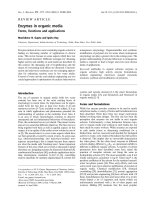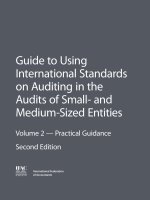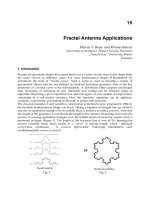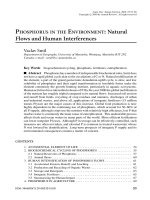Enzymes in the Environment: Activity, Ecology and Applications - Chapter 13 doc
Bạn đang xem bản rút gọn của tài liệu. Xem và tải ngay bản đầy đủ của tài liệu tại đây (713.14 KB, 36 trang )
13
SearchforandDiscoveryofMicrobial
EnzymesfromThermallyExtreme
EnvironmentsintheOcean
JodyW.DemingandJohnA.Baross
UniversityofWashington,Seattle,Washington
I.INTRODUCTION
Thevastarrayoforganicandinorganiccompoundsproducedinanddeliveredtotheocean
makeitahavenforanextraordinarydiversityofmicroorganismsthatuseadiversearray
ofcatalyticagentsinthesynthesis,transformation,anddegradationofthesematerials.
Themicrobialproductionofenzymesfunctionalatmoderatethermalconditionsinthe
marineenvironmentiswellknown(seeChapter4).Herewearguefromobservations,
experimental results, and hypothetical scenarios that thermally extreme environments in
the ocean offer new and continuing vistas for discovering enzymes of unique metabolic,
ecological, and evolutionary significance, as well as for creating practical applications in
the realms of biotechnology and bioremediation. We explore the physical features and,
perhaps surprising, commonalities of very hot and very cold marine habitats, as well as
the enzymes and producing microorganisms already known from these environments, to
develop predictions of enzymes awaiting discovery. The potential for application of geno-
mics, proteomics, and other forms of genetic access and manipulation as new search and
discovery tools that can be made even more powerful with ecological insight is high-
lighted.
The thermal end members of marine habitats on this planet are submarine hydrother-
mal systems (1), including the virtually unexplored subsurface biosphere beneath their
seafloor expressions (2–5), and subzero sea-ice systems (6), including their connections
to permanently cold deep waters and sediments of polar regions (7). In considering these
thermally extreme environments, we build upon the axiom that extreme temperatures,
especially the sharp thermal gradients they create in the ocean, have provided powerful
evolutionary forces to select for microbial enzymes with unique characteristics, unlike
those of their moderate temperature counterparts. Inextricably related to the selective pres-
sure of extreme temperature in these targeted environments are the elevated hydrostatic
pressures at hydrothermal vents, which act to keep superheated fluids liquid in the deep
sea (to temperatures above 400°C) (1), and the elevated salinities and other solutes in sea-
ice formations, which act to keep supercooled fluids liquid even at the coldest of winter-
Copyright © 2002 Marcel Dekker, Inc.
time temperatures (to Ϫ35°C) (8,9). Just as organisms themselves must have suitable
intracellular and membrane-bound enzymes to metabolize, replicate, and transcribe deoxy-
ribonucleic acid (DNA) and grow under such combinations of extreme conditions, the
extracellular transforming and degradative enzymes they release into their surroundings
must be able to persist long enough to provide a useful nutritional return. Although our
tendency to focus more on extracellular than intracellular enzymes in this chapter stems
from the more abundant information available on them and the applied interests in them
(the two are linked), it is also rooted in an ecological appreciation of their importance to
the producing organisms in their natural settings (10).
II. TERMINOLOGY
A. The Microorganisms
Until recently, the search for microbial enzymes from extreme environments has invariably
involved the producing organisms themselves, either in laboratory culture or in their native
habitats. Terms used to describe the behavior of microorganisms at both ends of the tem-
perature spectrum have undergone a series of revisions over the years, and sometimes
apparent misuse, as the information base has increased and research emphases have
changed (11,12). Here, as elsewhere (1,11), we consider hyperthermophilic microorgan-
isms as those that grow optimally at a temperature of 80°C or higher and to a maximal
temperature of at least 90°C; most are of marine origin, many of them isolated from the
type of hydrothermal vent systems that we consider here. All are relatively new to science;
they are differentiated from the more moderate thermophiles, known for decades, that
have maximal growth temperatures between 55°C and 80°C (thermophilic eukaryotes,
algae and fungi, have maximal temperatures of 50°Cto60°C). At the lower end of the
temperature spectrum, we follow Morita’s (13) definition of psychrophilic microorganisms
as those that grow optimally at 15°C or lower and to a maximal temperature of 20°C.
Psychrophiles are distributed worldwide in every type of cold environment, but those from
marine environments have been the object of study for nearly a century (14). Each of
these definitions, for hyperthermophiles and for psychrophiles, clearly emphasizes optimal
activity at an extreme end of the temperature spectrum, coupled with the upper temperature
limit for growth. Consistent terms emphasizing the lower-temperature limit for growth
are generally missing from the literature.
The issue of a lower-temperature limit has contributed to some confusion in the
literature, especially in the realm of psychrophily, because of the many organisms capable
of growth (albeit slow) at near-freezing temperatures, even though they grow optimally
above, and often well above, 20°C. Depending on author and research perspective, such
organisms have been called psychrotrophic, psychrotolerant, or facultatively psychrophilic
(12,13,15). Blurring the picture further is the recent use of psychrophilic to mean any
organism capable of growth at near-freezing temperatures, regardless of its growth opti-
mum. Some have argued that growth yield can be the more important variable and that
yield is not always linked to growth rate (16). Here we follow our oceanographic perspec-
tives and use psychrotolerant to refer to those organisms that can grow at near-freezing
temperatures but most rapidly at approximate room temperature. This choice parallels the
(high-pressure) deep-sea literature, in which barotolerant refers to an organism that can
grow at elevated hydrostatic pressures but most rapidly at approximate room (atmospheric)
Copyright © 2002 Marcel Dekker, Inc.
pressure(17).Wereservetheuseofpsychrophilictoreferonlytoanorganismoptimized
forgrowthatlowtemperatures(T
opt
Յ15°CandT
max
Ͻ20°C)(13).
Lessconfusioninterminologyfiguresinthehigh-temperatureliterature,sincethe
situationinthereversedirectiondoesnotappeartoapply;thatis,fewifanyorganisms
withoptimalgrowthtemperaturesbelow80°Ccanalsogrowat90°Corhigher.Asorgan-
ismswithincreasinglyhighertemperatureoptimaandmaximaforgrowth(asageneral
rule,theyincreaseintandem)havebeendiscovered,termshaveeasilyaccommodatedthe
newinformation,fromthermophilic(T
opt
Ն55°CandT
max
ϭ80°C)tohyperthermophilic
(T
opt
Ն80°CandT
max
Ն90°C)tosuperthermophilic(T
max
Ն115°C)(1,2).Theterm
extremelythermophilic,usedsomewhatlooselyinthepast,hasgenerallybeenretiredin
favorofthedefinedtermhyperthermophilic.Inthecolddirection,thetrendappearsto
befrompsychrophilic(T
opt
Յ15°CandT
min
ϭ0°C)(13)toextremelypsychrophilic(T
opt
Յ
5°CandT
min
ϭϪ5°C);(18)tosuperpsychrophilic(T
min
ϽϪ5°C)(9).
B.TheEnzymes
Auniformapproachtoclassifyingenzymesonasimilarthermalbasissofarhaseluded
theresearchcommunity.Acommonapproachhasbeentorefertotheenzymeaccording
tothegrowthoptimumoftheorganismthatproducesit,ratherthanaparticularthermal
featureoftheenzymeitself.Enzymesproducedbyhyperthermophilicorganismshave
thusbeencalledhyperthermophilicenzymes,whereasthoseproducedbypsychrophilic
organismshavebeencalledpsychrophilicenzymes.Thisapproachworksreasonablywell
atthehighendofthetemperaturescale,inthesensethatmostenzymesproducedby
hyperthermophilesalsotendtobehyperthermophilicintheirbehavior,showingatempera-
tureoptimumforcatalyticactivity(Table1)closetoorgreaterthantheT
opt
forgrowth
oftheorganism.Theexceptionsarealmostalwaysintracellularenzymes(fouroffive
casesshowninTable1).
Thegreaterpotentialforconfusionagainemergesatthelowendofthetemperature
scale.Referencetoanenzymeunderstudyaspsychrophilicrarelymeansthattheenzyme
itselfexpressesoptimalactivityatatemperatureof15°Corlower,sincesofewenzymes
withsuchalowT
opt
forcatalyticactivityareknown(Table2).Dependingontheperspec-
tive of the investigator, reference to an enzyme as psychrophilic can mean that it was
produced by a psychrophilic organism, produced by a psychrotolerant organism, active
at low temperatures (even if not optimally), or unstable at high temperatures (regardless
of its thermal activity optimum). Some papers report T
opt
for catalytic activity but not for
organism growth, or vice versa, whereas others report maximal temperatures for enzyme
stability (or enzyme stability at a temperature selected for reasons of convenience, not
necessarily biological or ecological relevance) but not thermal optima (Table 2). We can
find no examples of an enzyme from a psychrophile that has a T
opt
for activity lower than
the growth optimum of the producing organism (Table 2), in contrast to the situation for
hyperthermophiles (Table 1).
The most common terms in use for enzymes from psychrophilic (or psychrotolerant)
microorganisms are cold-active and cold-adapted, circumventing the terminology problem
that stems from an emphasis on T
opt
for catalytic activity and focusing instead on the
ability of the enzyme to express significant activity at low temperatures, given a reference
point for maximal activity at room temperature or higher. In light of the still limited
information available on enzymes from psychrophiles (compared to hyperthermophiles),
we adopt a similar approach in this chapter, at the same time underscoring the prediction,
Copyright © 2002 Marcel Dekker, Inc.
Table 1 Examples of Enzymes from Hyperthermophilic Heterotrophic Microorganisms, All Isolated from Marine Hydrothermal Vents, Ordered by Strain
(T
opt
for Growth) and Thermal Activity Optimum
Enzyme
Growth activity Enzyme half-life
Organism (domain) T
opt
(°C) Enzyme, function T
opt
(°C) (time, °C)
a
References
Thermotoga maritima 80 4-α-Glucano-transferase, starch hydrolysis
b
70 3 h @ 80 81
(Bacteria)
β-Galactosidae, lactose hydrolysis
b
80 N.A. 79
Hydrogenase, hydrogen production Ͼ90 2 h @ 95 147, 148
Xylanase A, xylan hydrolysis
b
92 45 min @ 90 149
Xylanase B, xylan hydrolysis
b
105 3 h @ 90 149
Glucose isomerase, glucose to fructose 105–110 10 min @ 120 73
Thermotoga neopolitana 80 Mannanase, mannan hydrolysis
b
91 13 h @ 90 84
(Bacteria) 35 min @ 100
Cellulase celA, cellulose hydrolysis
b
95 N.A. 85
Xylanase, xylan hydrolysis
b
Ͼ100 N.A. 150
α-Galactosidase, lactose hydrolysis
b
100–103 9 h @ 85 84
2h@90
3 min @ 100
Cellulase celB, cellulose hydrolysis
b
106 130 min @ 106 85
26 min @ 110
Copyright © 2002 Marcel Dekker, Inc.
Thermococcus litoralis 85 DNA polymerase, DNA amplification 75 7 h @ 95 88, 151
(Archaea)
Amylopullulanase, starch hydrolysis
b
115 N.A. 73
Pyrococcus furiosus 100 DNA polymerase, DNA amplification Ͼ75 20 h @ 95 92, 152
(Archaea)
Protease, peptide bond hydrolysis 85 N.A. 153, 154
Hydrogenase, hydrogen production 95 2 min @ 100 69, 147, 155
α-Amylase, starch hydrolysis
b
100 2 min @ 120 156, 157
β-Glucosidase, cellobiose hydrolysis
b
102–105 85 h @ 98 158
Protease PfpI, peptide bond hydrolysis 105 N.A. 159
β-Mannosidase, mannan hydrolysis
b
105 60 h @ 90 160
Invertase, sucrose inversion 105 48 min @ 95 161
α-Glucosidase, maltose hydrolysis 110 48 min @ 98 158, 162
Serine protease, peptide bond hydrolysis 115 33 min @ 98 163
Amylopullulanase, starch hydrolysis
b
125 12 min @ 125 73
Pyrococcus sp. strain 100 Amylopullulanase, starch hydrolysis
b
118 10 min @ 120 74
ES4 (Archaea)
a
N.A., not available.
b
Extracellular enzyme.
Copyright © 2002 Marcel Dekker, Inc.
Table 2 Recent
a
Examples of Enzymes from Psychrophilic
b
Heterotrophic Marine Bacteria, Ordered by Strain (Environmental Source and T
opt
for
Growth) and Thermal Activity Optimum
Enzyme Enzyme
Growth activity half-life
Source Organism T
opt
(°C) Enzyme T
opt
(°C) (time, °C) References
Sea ice, Antarctic Vibrio sp. strain ANT300 7 Triosephosphate isomerase N.A.
c
9 min @ 25 166
Colwellia demingiae strains ACAM607, IC169 10–12 Trypsins
d,e
12–14 N.A.
c
105
Phosphatases
d,e
17–23
Proteases
d,e
28–30
Cytophaga-like sp. strains IC164, IC166 N.A. β-Galactosidase
d,e
15 N.A.
c
105
Phosphatase
d,e
19
Proteases
d,e
20—27
α-Amylase
d,e
25
Trypsin
d,e
30
Pseudoalteromonas sp. strain IC000 N.A. Trypsin
d,e
22 N.A.
c
105
Protease
d,e
29
Shewanella gelidimarina strain ACAM456 N.A. β-Galactosidase
d,e
24 N.A.
c
105
Copyright © 2002 Marcel Dekker, Inc.
Sediments, Arctic Aquaspirillum arcticum 4 Malate dehydrogenase N.A.
c
10 min @ 55 121
Colwellia sp. strain 34H 5–8 Protease
d,e
20 N.A.
c
20
Seawater, Antarctic Pseudomonas aeruginosa N.A. Protease
e
Ͻ25 2 min @ 45 23, 167
Alteromonas haloplanctis Ͻ15 α-Amylase
e
27 10 min @ 50 16, 168
Bacillus sp. strains TA39, TA41 N.A. Subtilisin
e
45 90 min @ 25 16, 130
10 min @ 50
Animal-associated, Psychrobacter immobilis Ͻ10 β-Lactamase
e
35 5 min @ 50 169,170
Antarctic (or N.A.) Lipase
e
N.A. N.A.
c
171
Shewanella sp. N.A. Phosphatase 30 10 min @ 50 172
5 min @ 60
Flavobacterium balustinum strains P104–107 10–20 Proteases
e
30–40 30 min @ 20 173
15 min @ 60
Flavobacterium sp. N.A. β-Mannanase
e
35 N.A.
c
174
Deep sea Vibrio sp. strain 5709 20 Protease
e
40 20 min @ 40 120
Vibrio sp. strain 5710 N.A. Malate dehydrogenase N.A.
c
N.A.
c
140
Photobacterium sp. strain SS9 N.A. Malate dehydrogenase N.A. N.A. 175
N.A., not available.
a
Earlier work (e.g., 15,164,165), sometimes based on culture supernatants or partially purified protein preparations, reported similar thermal activity optima (in the range of 25°C–
50°C) and thermostabilities (e.g., 10 min at 40°C–70°C; 164).
b
Only the organisms listed from sea ice or sediments are strict psychrophiles (with both T
opt
for growth Յ15°C and T
max
Յ 20°C); those from polar seawater, polar animals, or
the deep sea have been called psychrophilic by various investigators, but are not or may not be psychrophiles as defined here.
c
Indications of optimal activity shifted to lower temperature or of pronounced heat lability.
d
Preparation may have included multiple isozymes.
e
Extracellular enzyme.
Copyright © 2002 Marcel Dekker, Inc.
assupportedbyinformationfrom1999and2000(Table2)(19,20),thatnewdiscoveries
willrefocusattentiononthermalactivityoptimathatareindeedpsychrophilic(Յ15°C).
Intherealmofapplicationsateitherendofthetemperaturespectrum,however,neither
activityoptimanorthermalstabilitymaybetheessentialenzymefeature:fidelityofampli-
fication(inthecaseofDNApolymerases)ornoveltyofchemicaltransformationmay
takeprecedence.Ultimately,anunderstandingofthebalancebetweenactivityoptimaand
thermalstabilitymustbeachieved.Fortunately,thisgoalmotivatesmuchoftherecent
researchonenzymesfrombothextremelyhotandextremelycoldmarineenvironments.
III.BIOCHEMICALCHALLENGESATTHERMALEXTREMES
A.CommonandDivergentThemes
Theabilityofanorganismtogroworsurviveatanextremetemperatureposesspecial
physiologicalandbiochemicalchallenges.Successdependsuponbothextrinsicandintrin-
sicfactors:elevatedhydrostaticpressureorsoluteconcentrationathightemperatures(as
atdeep-seavents)andhighsaltorothersoluteconcentrationatlowtemperatures(asin
sea-icebrines).Thesecanextendthepermissivetemperaturerangebytheireffectsonthe
liquidstateofwater(andonothermolecules);intrinsicfactorsassociatedwithuniquely
evolvedstructural,catalytic,andinformationalmacromoleculesareessential.Thestark
contrastinlevelsofthermalenergyinherenttoveryhotandverycoldenvironmentshas
ledtodivergentgrowthandsurvivalstrategiesforhyperthermophilesandpsychrophiles.
Inthefaceofveryhighthermalenergyinsuperheatedfluids,thesuccessfulhyperther-
mophilemaintainsmetabolicintegrityandcontrolbyvirtueofremarkablyheat-stable
membranes,cellwalls,andmacromolecules,survivingsupramaximaltemperaturesvia
unique‘‘heat-shock’’proteinsthatstabilizemacromoleculesatotherwisedenaturingtem-
peratures(21,22).Inthefaceofverylowthermalenergyinsubzerofluids,thesuccessful
psychrophilemustcontendwithgreatlyreducedratesofphysical(e.g.,diffusional),physi-
ological,andbiochemicalprocesses,maintainingadequatemembranefluiditysimplyto
acquirenutritionfromitssurroundings.
Comparedtoextrinsicfactorsinvolvedingrowthandsurvivalstrategiesatthermal
extremesortotheintrinsicfactorsofstructurallipidsandinformationalmacromolecules,
lessisknownaboutthevastarrayofenzymesrequiredbyanorganismtobesuccessful
ateitherendofthetemperaturespectrum.Somebasicpropertiesthatemergefromacom-
parisonoftheextremesincludethatenzymesfrompsychrophileshavealowerfreeenergy
ofactivationthanenzymesfromthermophiles(23),inkeepingwiththedisparatelevels
ofthermalenergyintheirrespectiveenvironments.Bydefinition,cold-adaptedenzymes
haveupperdenaturationthresholdsatrelativelymoderatetemperatures(30°C–60°C)com-
paredtohyperthermophilicenzymes,eventhoughthesamedoesnotholdtrueinthe
reversedirection:onlysomehyperthermophilicenzymesareknowntodenatureatcold
temperatures(nearroomtemperatureorbelow)(24);mostremainstableasthetemperature
drops.Inspiteoflimiteddata,arelationshipdoesappeartoexistbetweenthethermal
optimaforenzymeactivityandthehalf-lifeorthermostabilityoftheenzymeatsupraopti-
maltemperatures:thehighertheT
opt
foractivitythelongerthelifetimeatevenhigher
temperatures(comparedataforxylanases,forDNApolymerases,andforamylopullanases
inTable1andforproteasesinTable2).
Although analyses of the most basic features of enzymes—their amino acid se-
quences—have yielded some insight into what makes an enzyme uniquely adapted to one
Copyright © 2002 Marcel Dekker, Inc.
thermalextremeortheother,thecombinationofthisinformationwithotherbiochemical
andtheoreticalstudieshasbeenthemostrevealing(e.g.,25–27).Forexample,features
ofasuccessfulhyperthermophilicenzymecanincludeincreasedcompactness,stabiliza-
tionofαhelices,increasedsaltbridgesandionpairsforstabilizingsecondarystructures,
oranincreasednumberofhydrogenbonds,eachtowardretainingstabilityinthefaceof
veryhighdenaturingtemperatures.Thecold-adaptedenzyme,incontrast,showsgreater
flexibilityandlesscompaction,lackssaltbridgesandionpairs,andhasareducednumber
ofhydrogenbonds,alltowardretainingactivityundervery-low-energynear-freezingcon-
ditions.Noorganism,however,appearstohaveevolvedauniformstrategyforstabilizing
orallowingactivityofallofitsenzymesatagivenextremetemperature.Instead,itssuite
ofenzymesencompassesarangeofuniquecombinationsofmolecularadapationsthat
reflectthehostofcomplexevolutionaryandecologicalfactors,includingacquisitionof
successfultraitsthroughgeneticexchangeintheenvironment(28),thatdefineacontempo-
rarymicroorganism.
Acommonthemeforhyperthermophilyandpsychrophily,relatingenzymesdirectly
totheproducingorganism(andthusallowingatleastsomecommonterminology),isthat
thehighertheT
opt
forgrowthoftheorganism,thehighertheT
opt
foritsenzymes:justas
enzymesoptimizedforactivityatthehighesttemperaturesclearlyderivefromhyperther-
mophilesadaptedtogrowthatthehighesttemperatures(Table1),enzymeswiththelowest
thermaloptimaderivefrompsychrophileswiththelowestgrowthoptima(Table2).In
fact, all known cold-adapted enzymes express thermal activity optima that fall above the
T
opt
for growth of the producing strain (Table 2). Although the same holds true in large
part for hyperthermophilic enzymes, some (mostly intracellular) enzymes are optimized
for activity below the T
opt
for growth (Table 1), retaining only minimal stability (half-
lives of a few minutes) as the maximal temperature for growth is approached (29).
B. Intracellular Versus Extracellular Enzymes
If activity optima for enzymes, whether from hyperthermophiles or psychrophiles, are
examined according to general cellular location of the enzyme—intracellular (essential
to metabolism, DNA processing, growth) versus extracellular (typically hydrolytic en-
zymes that act independently of the organism)—the T
opt
for extracellular enzymes almost
always falls above, and sometimes well above, the T
opt
for growth (80% of the hyperther-
mophilic cases in Table 1; 100% of the psychrophilic cases in Table 2). Attempts to
understand this locational discrepancy in thermal optima have been made by researchers
studying psychrophilic and psychrotolerant bacteria. They have asked, What evolutionary
pressure would select for extracellular enzymes optimized for activity at temperatures well
above the T
opt
for growth (25)? Would not an extracellular enzyme with greatest activity
at the T
opt
for growth be ideal—or better yet, at the in situ temperature of the environment,
which in the case of psychrophiles is invariably lower than its growth optimum? Why
should extracellular enzymes have evolved differently in thermal properties than intracel-
lular enzymes?
The biochemical processes underlying enzyme activity versus stability at a given
temperature have been proposed as a primary explanation for the phenomenon (16,23,25).
Basically, an enzyme is least stable at the higher end of the temperature range over which
it is active. For example, a psychrophile-derived extracellular enzyme optimized for activ-
ity at 30°C has a shorter half-life at that temperature than at lower ones. It is thus more
stable at the growth optimum for the organism (Յ15°C) and has its longest lifetime at
Copyright © 2002 Marcel Dekker, Inc.
thetypicalsubzerotemperaturesencounteredinapolarmarinesetting.Aslongasthe
enzymeretainsenoughactivityatthelowertemperatures,itslongerlifetimecanbeseen
asabenefittotheproducingorganism.Whatconstitutes‘‘enough’’and‘‘benefit’’has
beenexploredinaquantitativemodelofmicrobialforagingbyextracellularenzymes
underthermallymoderateconditions(10);nosimilarquantitativeanalysisisavailablefor
thermalextremes(butsee9).Thefollowingconsiderationofenzymeforaginginlightof
thecommonphysicalfeaturesofourfocalenvironmentsunderscoresthepromiseofthis
strategyforhyperthermophilesandpsychrophilesandforanewgenerationofforaging
modelsincorporatingextremetemperatures.
IV.MICROBIALFORAGINGUSINGEXTRACELLULARENZYMES
A.GeneralFeatures
ThequantitativemodelingworkofVetterandassociates(10)addressesthespecificuse
ofextracellularenzymesasabacterialforagingstrategyinmoderate-temperaturemicroen-
vironmentsrichinparticulateorganicmaterial(POM),ofasizetoolargetopassthecell
membranewithoutextracellularhydrolysis.Thetypicalmarineenvironmentwherethis
strategyisdemonstrablyadvantageousinvolvesanaggregationofPOM-richparticles,
eithermineralgrainswithsorbedPOM(asinmarinesediments),ororganic-richdetrital
particles(asinaggregatessinkingthroughthewatercolumn).Adequateporespace
throughwhichvarioussolutes,fromenzymestoPOMhydrolysate,candiffuseisalso
essential(Fig.1).Althoughnotyetconsideredinamodelingcontextfortheirspecial
features,bothhydrothermalstructuresandseaicearerichininteriorcolonizablesurfaces,
oftenladenwithorganicmaterialinpatches,andcanbehighlyporous.Theyrepresent
idealsettingsfortheuseofextracellularenzymesasaforagingstrategyandforrecognition
andimproveddissectionoftheconsequencesofevolutionarypressureonenzymeadapta-
tionatextremetemperatures.
B.ForaginginHotSulfideStructures
Activelyventingsulfidestructuresontheseafloorare,bydefinition,composedofmineral
grains,ofvariablecompositiondependingonlocalchemicalandthermalconditionsfor
precipitationanddeposition(30).Theyarecolonizedintheircoolerportionsbyanimals
thatproduceorganic,especiallychitinous,structuresandpolymersthatremainafterthe
organismhassoughtnewterritoryorsuccumbedtoeitherapredatororthermochemical
changeinthehabitat.Thesulfideformationsareclearlyporous,oftenfunctioningasvisi-
blediffusersreleasingcooledhydrothermalfluidsintothesurroundingseawater.Their
interiorportionsareknowntosupportabundantheterotrophic(andother)microbialpopu-
lations(1,31,32),zonedphylogenetically(BacteriaversusArchaea;Fig.2)accordingto
permissivetemperatures.Thepredictionfromthiscombinationoffeaturesaloneisthat
POMforagingusingextracellularenzymesisanimportantstrategyforthegrowthand
survivalofheterotrophicmicroorganismslivingwithinthesestructures.Theadditionalfact
thatknownhyperthermophilicheterotrophsreleaseawidevarietyofhighlythermostable
enzymesintoculturemediainthelaboratory(Table1)makesseafloorsulfidestructures
obvious sites for future exploration and discovery of new enzymes, especially extracellular
hydrolytic enzymes. Although no direct environmental searches of enzyme activity in
hydrothermal structures have yet been made to our knowledge, such an approach could
Copyright © 2002 Marcel Dekker, Inc.
Figure1Schematicdiagramofanaggregateofparticleswithanimmobileenzyme-releasing
bacteriumatthecenter.Theaggregateenvironmentiscomposedofimpermeableinorganicgrains
(shadedshapes),patchesoforganicmaterial(blackshapes,toolargetocrossthecellmembrane)
sorbedtothegrains,andseawater-filled(orbrine-filled,inseaice)spacesthroughwhichsolutes
diffuse.Heavyarrowsrepresentenzymediffusingawayfromtheorganism;dashedarrows,hydroly-
satediffusingawayfromtheorganicmaterial,whereitisproducedenzymatically.(Modifiedfrom
Ref.10.)
provefruitful,justasnewmicroorganismscontinuetoemergefromdirectexamination
ofseafloorhydrothermalsitesandeffluentsfromthesubsurfacebiosphere(5,32,33).
Specialfeaturestoconsiderinthesearchforhyperthermophilicenzymes(ororgan-
isms)orinpredictivemodelingeffortsinadvancearethesharptemperaturegradients,
establishedacrossdistancesthatmeasureincentimeters,inactivelyventingsulfidestruc-
tures(Fig.2);theotherthermallylinkedgradientsinchemicalparameters,frompHto
Eh (oxidation status) to a multitude of dissolved inorganic and organic species (1,28); and
the influence of advection versus diffusion through pore spaces. Since hydrostatic pressure
figures importantly at deep-sea hydrothermal vents, acting to keep superheated fluids in
the liquid phase and to select for barophilic and barotolerant microorganisms (2), it must
also be considered in the study of microbial enzymes from these environments (28,29,34).
The critical feature of the lifetime of a given enzyme, especially when sorbed to mineral
grains within an actively flushing vent structure, determines not only its detectability and
utility as a foraging tool to the producing organism and its neighbors (10), perhaps in
zones too hot to permit the organism itself (28), but also its performance immobilized
under extreme conditions and thus its attraction to biotechnologists.
Copyright © 2002 Marcel Dekker, Inc.
Figure 2 Schematic diagrams of examples of the hottest (seafloor hydrothermal sulfide structure)
and coldest (wintertime Arctic sea ice) marine habitats, depicting common physical features of inte-
rior colonizable surface area, fluid-filled pore space, and sharp thermal gradients. Note that bacterial
and archaeal zonations have been explored in sulfide structures (modified from Ref. 28), but not
yet in sea ice (modified from Ref. 45), whereas fine-scale temperature and chemical properties of
pore fluids are better known for sea ice (e.g., salinity gradients parallel thermal gradients inversely)
than sulfide structures.
Copyright © 2002 Marcel Dekker, Inc.
C.ForaginginSubzeroSeaIce
ThethreebasicfeaturesoftheenzymeforagingmodelofVetterandcoworkers(10)for
particleaggregates(Fig.1)alsopertaintotheotherendofthetemperaturespectrumfor
microbiallifeandenzymaticactivityepitomizedbyseaice.Aggregatesofmineralgrains
andotherparticlesandprecipitates(includingmicroorganismsandsalts)areknownto
concentratewithinthefluidinclusionsofseaice(6),mostnotablyintheArctic,where
seabedsedimentsentrainintocoastaliceasitforms(35).TheseaggregatesincludePOM-
richdetritalparticles(36)andlargeexopolymers(37)asaresultoftheautotrophicand
heterotrophiccommunitiesthatdevelopannuallywithintheicecover(38–40),aswellas
generallyelevatedlevelsofdissolvedorganiccarbon(41,42)includingenzymes(19,20).
Thesea-icematrixisalsohighlyporous,especiallyinsummertime,flushingregularly
withthetidesorinfluenceofwaveswhileretainingparticleaggregatesandorganisms
withinit(43,44).Evenduringwintertime(intheArctic),whensea-icetemperaturescan
dropbelowϪ20°C(Fig.2)toaslowasϪ35°C,dependingonsnowcoverandatmospheric
conditions(8),interiormovementsofbrinefluidthroughfinelyconnectedchannelsare
possibleonascalerelevanttobacteriaandenzymes.Thishasbeendemonstratedby
physicalanalysesofundisturbedicesectionsusingnuclearmagneticresonance(NMR)
andtransmissionmicroscopy(45).
Incontrasttoresearchonhydrothermalstructures,lessinformationisavailableon
theabundanceorpossiblezonation,phylogeneticorotherwise(Fig.2),ofmicroorganisms
inthesecoldestofwintertimesea-icehabitats(e.g.,18,36).Onlyin1999wasanonde-
structive(nonwarming,nonmelting)methodforstudyingmicrobiallifeinsupercooled
icedeveloped(36).Althoughextremetemperaturesdeterminethesolidphaseofboth
hydrothermalstructures(bycontrollingmineralprecipitationreactions)andseaice(by
freezingwater),onlythehydrothermalstructureremainsintactforreadystudyattempera-
tureslessextremethanthoseinsitu.Sea-icestructurechangesnonuniformlywithevery
incrementalchange(upordown)intemperature,presentingspecialchallengestoa
postsamplingevaluationofinsitumicrobialcommunities,products,orprocesses.
Nevertheless,thepredictionfromthethreebasicfeatures(abundantattachmentsites,
organicmaterial,andporosity)thatenzymeforagingisanimportantmicrobialstrategy
forgrowthandsurvivalinseaicehasbeensupportedbydirectenvironmentalmeasure-
mentsinbothwintertime(18)andsummertimesea-icesamples(19,20).Notonlyhave
hydrolyticactivitiesonsubstrateanalogsforprotein,chitin,andvariouscarbohydrates
beenreadilydetected,but,wheremeasuredandcomparedacrossothersubzeroenviron-
ments(Arcticseawaterandsinkingaggregates),thelowestthermaloptimaforenzyme
activitieswereobservedinmultiyearseaice(19).Theoptimawereconsistentlypsychro-
philic,downto10°C,comparedtopreviousreportsof30°C–50°C(19,20,andcitations
therein)(Table2).Inotherwords,theicecoverovertheArcticOcean,whichinsome
areaspersiststhroughadecadeofwinters(rarelyifeverthecaseinAntarcticwaters),
clearlyselectsforcold-adaptedandevenstrictlypsychrophilicenzymes,asitdoesfor
psychrophilicorganisms(discussedlater),makingitanobviousenvironmentforcontinued
searchanddiscoveryofnewenzymesinthisthermalclass.
Specialfeaturestoconsiderinasearchforcold-adaptedenzymesinseaiceresemble
thoseforseafloorsulfidestructures,albeitatsubzerotemperatures:sharpthermalgradients
inwintertimeice(Fig.2),linkedsalinity(andotherchemical)gradients(Fig.2),andthe
influence of advection versus diffusion. Elevated salinities, as well as concentrations of
other solutes, are key to depressing the freezing point and maintaining fluid-filled pore
Copyright © 2002 Marcel Dekker, Inc.
spaces.Infact,physiologicalstudiesofsea-icebacteriasuggestthatsalinity(andpH)
gradientsmaybeascriticaltopotentialmicrobialsuccessionandzonationwiththeice-
brinematrixasthecardinalgrowthparameteroftemperature(46).Uniquetothecoldend
ofthetemperaturespectrumexemplifiedbyseaicearetheproblemsofincreasedviscosity
astemperaturedropsandsalinityrises(inwintertime)andofinteriorverticalmixingwith
tidalandwaveaction(insummertime).Thelifetimeofanextracellularenzymesorbed
toparticlesurfacesinsituunderextremelycold,saline,andviscousconditionsisasimpor-
tantafactortotheorganismsinseaice(andtothosewhostudythem)asitisinthecase
ofextremelyhot,chemicallyreduced,andnonviscousconditionswithinhydrothermal
ventstructures.
Indeed,enzymelifetimeorstabilityemergesasacriticalfactorinscenariosthat
helptoexplainwhyextracellularenzymesappearoptimizedforactivityattemperatures
wellabovewhattheyexperienceintheirnaturalsettings,whetherveryhotorverycold.
Inanearlyecologicalscenarioforsubzeromarinesediments(47),absentspecificinforma-
tiononenzymeactivityrelativetolifetime,bothcharacteristicswereassumedtobere-
strictedatinsitutemperature,suchthatluxuryorexcessiveproductionofextracellular
enzymeswasinvokedtoaccountforsufficienthydrolyticreturntosupportthemicrobial
communityclearlypresentintheenvironment.Indeed,somepsychrophileshavesince
beenshowninthelaboratorytoproducemaximalamountsofextracellularenzymesat
suboptimalgrowthtemperatures(48),wheretheyalsoappeartorequireelevatedconcen-
trationsofdissolvedorganicmatterforactivity(49,50).However,wealsonowunderstand
thatanenzymeoptimizedforactivityatatemperaturewellabovethegrowthoptimum
fortheproducingorganism(andthustheinsitutemperature,inthecaseofpsychrophiles)
ismorestableatthatlowergrowth(orinsitu)temperaturethanatitsownT
opt
foractivity
(see16,23,25fordiscussionatthebiochemical–molecularlevelastowhyacold-adapted
enzymeisrelativelyunstableinitsoptimallyactivestate).Thebalancebetweenactivity
andstabilityattheenvironmentallyrelevanttemperatureisthusalsounderstoodtodeter-
minetheextracellularenzymeofgreatestbenefittoitsproducer(9,10,12,16,19,20,23,
25,51).Wesuggestthatevolutionarypressureonmicroorganismstofeedcompetitively
andthussurviveinmicroenvironmentsrichinPOM(10)(Fig.1),butattemperatures
suboptimalforgrowth,hasselectedfortheproductionofextracellularenzymeswitha
balancebetweencell-freeactivityandlifetimethatfavorslongevityattheinsitutempera-
tureandthuslong-termreturnofhydrolysatetotheorganismanditsneighbors.Incontrast,
membrane-boundandintracellularenzymes(whichremainundercellularcontrolandthus
canberecycledandproducedanew,asneeded)withmaximalcatalyticactivityatagiven
temperaturehelpdefinethattemperatureastheoptimumforgrowth.
Thisenzyme-basedforagingandgrowthscenarioissofarexemplifiedbyapsychro-
philicbacterium,Colwelliasp.strain34H,enrichedfromnear-freezingArcticsediments
(7)andlatershowntobeoptimizedforgrowthat5°C–8°C(20).Theorganismproduces
extracellularproteaseswithunusuallylowthermaloptimaforactivity(20°C)(Table2).
Acrudepreparationoftheseproteasesfrommasscultivationoftheorganism,onethat
stillincludessomeintracellularproteases,expressesalowerthermaloptimumforactivity
(13°C)(Fig.3),aswouldbepredictedforsuchanenzymemix.Thefractionofenzyme
activityremaininginthispreparationafteraholdingperiodattheenvironmentallyrelevant
temperatureof0°Cwassignificantlygreaterthanthatremainingatwarmertemperatures
morepermissiveofbothgrowthandenzymeactivity(Fig.3).Inotherwords,tosurvive
and even grow in a permanently cold environment, an organism is well served both by
extracellular enzymes adapted for maximal activity at temperatures well above in situ (and
Copyright © 2002 Marcel Dekker, Inc.
Figure3Activityofacrudepreparationofproteases,specificallyleucine-aminopeptidase(LA-
Pase)activityfromColwelliasp.strain34H(19)relativetomaximumhydrolyticrate(R/R
max
)over
timeatdifferentincubationtemperatures.NoteLAPaseactivitydecreasingtogreaterextentathigher
temperatures(e.g.,59%lossafter76hat13°C,wherelossisattributedtoenzymedenaturation)
thanlowertemperatures(e.g.,33%lossafter76hat0°C),aswellastheshiftinactivityoptimum
from13°Cto10°Cto8°Cwithincreasingholdingtime.Solidlines,cubicsplinecurvefits;error
bars,95%confidenceintervalsfortriplicatemeasurementsateachtemperature.(FromAHuston
andJDeming,unpublished.)
optimalgrowth)temperature,andthuswell-designedatthemolecularlevelforalong
lifetimeofactivity(albeitatmodestcatalyticrate)attheenvironmentallyrelevanttempera-
ture,andbyintracellularenzymesmorecloselyoptimizedtoinsituconditionsandthus
formetabolismandgrowth.Asimilarscenario,onenotyetdiscussedintheliterature,
canbeproposedforhyperthermophilicenzymesandtheirproducingorganisms,often
foundatgrowth-permissivetemperaturesalongsharpthermalgradientswithinseafloor
sulfidestructures(Fig.2).Somesurprisesinthehyperthermophilicscenariomaybein
store,however,giventhefactthat someintracellularenzymesfromhyperthermophiles
(e.g.,DNApolymerases)expressthermalactivityoptimabelowgrowthoptimaofthe
producingstrainsyetalsoretainsignificantactivityevenatextremelyhightemperatures
(Table1).
D.FutureForagingScenarios
For both ends of the temperature spectrum, the described enzyme-based foraging and
growth scenarios and new ones yet to be developed benefit from rigorous and innovative
analysis of the characteristics of both intracellular and extracellular enzymes purified from
model organisms; the research and technology communities may benefit from discovery
of new enzymes or features of enzyme activity and thermostability in the process. Heeding
an ecological perspective should continue to be useful, given that thermal optima apparent
to researchers in short-term incubation experiments in the laboratory may not be synony-
Copyright © 2002 Marcel Dekker, Inc.
mouswiththermaloptimarelevanttoanorganismdependent(52)onafluxofdissolved
compoundsfromenzymesalreadyreleasedandfunctioningoverlongerperiodsinthe
environment.Forexample,notetheshiftinthermalactivityoptimaforcold-adaptedprote-
asesfrom13°Cto10°Cto8°Casafunctionofincreasingholdingtime(Fig.3).Wealso
suggestthatthefurtherexploratorystudyofmicrobialenzymesproducedinenvironments
characterizedbysharpthermalgradientsmayyieldenzymeswithbothhighcatalyticactiv-
ityandlonglifetimesatextremetemperatures(hotorcold),acombinationoffeatures
thatsofarhasbeenobservedonlyasaresultofgeneticengineering(describedlater)and
apparentlynotofevolutionarypressuresinnature.Thetemporallyandspatiallyfluctuating
thermalgradientswithinsulfidestructuresandseaicemayhaveprovidedthenecessary
selectivepressure.
V.STATUSOFTHESEARCHFORHYPERTHERMOPHILIC
MICROORGANISMSANDENZYMES
A.FocusonCulturableHyperthermophiles
Althoughthediscoveryofhyperthermophilicmicroorganismsatmarinehydrothermal
ventswasreportedin1982(53,54),theirpotentiallyexcitingactivitiesinsituhavebeen
studiedbyfewandremainpoorlyconstrained(1,28).Theinsituactivitiesofenzymes
thathyperthermophilesmayreleaseintotheirsurroundingsarecompletelyunknown.This
generallackofecologicalinformationonthefunctioningofeitherhyperthermophilicor-
ganismsorenzymesintheirnaturalsettingsstandsincontrasttowhatisknownabout
organismsandenzymesattheotherendofthetemperaturespectrum(seeSec.V.B);
marinepsychrophileshavebeenknownandstudiedforalmostacentury,muchofthe
workecologicallymotivatedfromtheoutset(14).Perhapsbecauseoftheimmediaterecog-
nitionofpracticalapplicationsforneworganismsfunctionalateverhighertemperatures
(11,55),researcheffortsnowongoingworldwidehavefocusedheavilyonorganismand
enzymeperformanceundercontrolledlaboratoryconditions,withspecificbiotechnologi-
calorindustrialgoalsmotivatingthechoiceoforganism,enzyme,ortestconditions.The
desiretoachieveafundamentalunderstandingofthebiochemical,metabolic,andgenetic
basisforhyperthermophilyhasoftenbeenpresentedasabettermeanstomanipulatestrains
andtheirproductsinvitroforcommercialpurposes.However,thefirstwhole-genome
sequenceforanyorganism,informationofthemostfundamentalnature,wasobtainedfor
thedeep-seahyperthermophileMethanococcusjannaschii(56).
Althoughecologicalconsiderationsbegstudyandenzymeforagingscenariosfor
hyperthermophileshavenotyetbeenformulated,theacquisitionofculturablehyperther-
mophilesfrommarinehydrothermalventsnowbordersonroutine.Currentrepositories
ofmarinehyperthermophiles,virtuallyallofwhichareobligatelyanaerobic,includerepre-
sentativesof25genera(examplesofwhichareshowninFig.4initalics)andphysiological
processes as diverse as methanogenesis, iron oxidization, other forms of chemoautotrophy,
sulfate reduction, and other forms of heterotrophy. With the exception of methanogenic
genera, which contain a wide range of thermal classes of methanogens, all of these genera
contain only hyperthermophilic organisms. As species have been added over time, culture
collections have become dominated by heterotrophic hyperthermophiles in a limited num-
ber of genera of both Archaea and Bacteria. These organisms typically require complex
organic compounds, including peptides or carbohydrates, to meet their carbon demands
(21,57). For the initially exciting pace of discovery of new and diverse hyperthermophilic
Copyright © 2002 Marcel Dekker, Inc.
Figure4Universalphylogenetictreebasedon16SrRNAsequences,showingthethreedomains
ofBacteria,Archaea,andEukaryaandfeaturingthehyperthermophilicgenera(initalics),which
fallwithintheprokaryoticdomainsofBacteriaandArchaea.Culturedpsychrophilesfallwithinthe
bacterialdivisionsofProteobacteria,Flavobacteria,andGram-positivebacteria(seeFig.5);the
marine Crenarchaeota comprise a large group of uncultured presumptive psychrophiles within the
Archaea. Distances were derived from numbers of mutations; the root, from sequences of the two
subunits of the F1-ATPases and the translation elongation factors EF-1α (Tu) and EF-2 (G). (Modi-
fied from Ref. 65.)
organisms to continue, however, innovative sampling and culturing approaches beyond
the now-standard heterotrophic sulfur-based media must be pursued. The continuing prom-
ise of discovery is evidenced by sampling strategies that access, at the seafloor, recent
fluid emissions from the subsurface biosphere (2,4) and by inventive culturing media that
yield new organisms and even the potential for novel metabolisms (33). For example, an
organism isolated in 2000 from a seafloor eruption site on the Gorda Ridge in the Northeast
Pacific Ocean likely represents a new genus and can function metabolically as a hetero-
troph, autotroph, and iron reducer (33).
Direct molecular approaches to assessing microbial diversity underscore the im-
mense and still untapped diversity of hyperthermophiles. Analyses of small-subunit ribo-
nucleic acid (RNA) sequences in environmental samples from terrestrial hot springs first
revealed this untapped diversity in both domains of Bacteria and Archaea (58,59). In an
early similar analysis of a submarine vent environment, specifically a sample of microbial
mat from Loihi Seamount (60), sequence analyses of fewer than 50 clones appeared to
reflect the untapped diversity in that habitat adequately. Subsequent analyses of the type
of sulfidic structures that we have targeted here, with their sharp thermal gradients and
higher end member values, have revealed a much greater degree of diversity, such that
analysis of hundreds of clones can still be inadequate to the task (31,32,61). The presence
of so many potentially unique and hyperthermophilic organisms necessarily indicates an
equally untapped diversity of hyperthermophilic enzymes, awaiting discovery.
In the meantime, culture collections have provided rich depths to plumb: several
Copyright © 2002 Marcel Dekker, Inc.
well-studiedheterotrophichyperthermophileshavebecomethetargetsofconcentrated
searchesforenzymeswithunusualthermalorotherproperties.Ofalloftheknowngenera
ofhyperthermophiles,onlythreeheterotrophicones—PyrococcusandThermococcusof
theArchaeaandThermotogaoftheBacteria—haveyieldedspeciesthatcanbegrown
reproduciblytohighcelldensitiesinthelaboratory,makingthemmodelorganismsfor
enzymestudiesinvitro.Infact,mostofthephysiologicalandenzymologicalstudieshave
beencarriedoutwiththreespecies(Table1),Pyrococcusfuriosus(62),Thermococcus
litoralis(63),andThermotogamaritima(64).
Byfarthelargestnumberofhyperthermophilicspecies,andmostofthecharacter-
izedhyperthermophilicproteins,belongtothearchaealfamilyofThermococcalesofthe
kingdomEuryarchaeota(65)(Fig.4).Thisfamilyiscosmopolitaninthatitsmembers
have been isolated from all hydrothermal environments sampled so far. All are known to
utilize carbohydrates by a glycolytic pathway that includes some unusual tungsten-con-
taining enzymes (24,66); most have a growth requirement for amino acids and peptides,
and for elemental sulfur (21). Tungsten concentrations, as well as levels of a wide variety
of other metals, can be very high in portions of seafloor sulfide structures deposited at
extreme temperatures (1,67), raising interesting evolutionary (and biotechnological) ques-
tions about metal-based enzymes and proteins in general. External sources of amino acids,
proteins, and other organic compounds for hyperthermophiles in their native settings have
been hypothesized (1), but not yet confirmed quantitatively.
For the two genera, Pyrococcus and Thermococcus, that constitute the family of
Thermococcales, approximately 40 species have been described. They are routinely iso-
lated from near-vent sites on the seafloor, from samples of originally hot sulfidic rocks
and other structures, from alvinellid worms that colonize actively venting structures, and
occasionally from samples of hot fluid emerging from such structures (1). Not only are
these hyperthermophiles easy to grow, they are also hardy, surviving storage under low-
temperature oxic conditions (68; J Baross, unpublished observations). Their ability to uti-
lize a wide range of organic substrates is reflected in their production of a diverse array
of hydrolytic enzymes (55,69,70) (Table 1); the oxidoreductases and dehydrogenases in-
volved in their fermentative metabolisms are the enzymes with metal (tungsten) centers
(24). Both the diversity and the properties of high-temperature enzymes can vary signifi-
cantly among similar species (69). Enough information is now available to recognize that
for a single organism the thermal properties of enzymes in the same functional class can
also vary significantly (see proteases for Pyrococcus furiosus in Table 1). The latter finding
opens new evolutionary and ecological scenarios for hyperthermophiles, e.g., the likeli-
hood that thermal gradients fluctuating in time and space in the vent environment, and
perhaps especially in the subsurface biosphere (1,28,33), may have selected for suites of
isozymes that make an organism uniquely adapted to survive, and possibly grow, across
a wider range of conditions than previously envisioned.
B. Focus on Commercially Important Enzymes
Apart from enzyme studies of some of the metalloproteins involved in hyperthermophilic
metabolism mentioned, most of the studies of the best-known species of Pyrococcus and
Thermococcus have focused on enzymes of commercial importance. Classes of hydrolytic
enzymes have received particular emphasis; catalytic activity at high temperatures and
extreme thermostability are frequently the properties of greatest interest. Hydrolytic en-
zymes are used by organisms to degrade peptides, complex carbohydrates, and lipids to
Copyright © 2002 Marcel Dekker, Inc.
low-molecular-weightcomponentsthatareeasilytransportedintothecell.Thebeststudied
ofthehyperthermophilichydrolyticenzymesaretheproteasesandtheglycosylhydrolases,
knowntoberemarkablythermostable(Table1)andtoshowveryhighratesofactivity
attheirthermaloptima.Theirfunctionsforthecelldiffer,however,withcellularlocation.
Somehyperthermophilicproteaseshavebeenreportedasintracellular,performingregula-
toryandcatabolicfunctions,includingdegradinginactiveproteinsoractivatingothers;
othershavebeenreportedasperiplasmicormembrane-associated,involvedindegrading
peptidesfornutritionandgrowth.Thosehydrolyticenzymesusedextracellularlyfigure
importantlyinthedevelopmentofenzymeforagingscenariosforhyperthermophiles.Dif-
ferentlylocatedproteaseshavebeenstudiedfromPyrococcusfuriosus:theirthermalactiv-
ityoptimarangefrom85°Cto115°C(Table1)(70),butwithnoobviousrelationship
betweenT
opt
andintra-orextracellularlocation.ComparedtoEscherichiacoli,however,
fromwhich36proteaseshavebeenidentified(71),onlyalimitednumberofproteases
havebeenobtainedandstudiedfromhyperthermophilic(orpsychrophilic)organisms.
Theglycosylhydrolasesfromhyperthermophiles,whichactoncomplexcarbohy-
drates,arethemostthermallystableenzymesyetcharacterized.WhenP.furiosusandT.
litoralis,normallyculturedinheterotrophicmediacontainingpeptides,aregrownonmalt-
oseinstead,theyreachhighcellyieldsandproduceanextremelythermostableα-glucosi-
dasewithanactivityoptimumof108°Candahalf-lifeof48hat98°C(72)(Table1).The
amylopullanasesfromPyrococcusspeciesES4andP.furiosushavethemostthermophilic
enzymesyetdescribed.Inhydrolyzingboththeα-1,4andα-1,6linkagesinstarch,they
showactivityattemperaturesabove125°C,wheretheyarestabilizedbytheadditionof
Ca
2ϩ
(73,74).Glycosylhydrolasesingeneralmaythusmeetthestartingpremisefora
successfulextracellularforagerwhentheinsituenvironmentaltemperaturefallsator
belowtheoptimalgrowthtemperatureoftheproducingstrain(e.g.,at100°Corbelow
inasulfidestructure):theirthermalactivityoptimaaremuchhigher,implyinggreater
longevityattheinsitutemperature.Evenwhereenzymelifetimeislimited,atextreme
pointsinthethermalgradientspanningasulfidestructure(Fig.2),beneficialenzymic
‘‘work’’fortheproducingorganismoritsneighborsispossible.Utilizablehydrolysate
maybeproducedandreturnedviadiffusiontomilderlocationsalongthegradientwhere
theorganismsreside.
Perhapsoneofthemoreecologicallyinterestingdiscoveriesaboutglycosylhy-
drolasesfromhyperthermophilesisthatThermococcuschitinophagus,anarchaealhyper-
thermophilefromdeep-seahydrothermalvents,canhydrolyzechitin(75).Subsequent
analysisofthegenomesequenceforPyrococcusfuriosusrevealedthepresenceoftwo
chitinases(aswellasothercarbohydrate-hydrolyzingenzymes),eventhoughthisorgan-
ismisnotknowntodegradechitininculture(76).Fewerglycosylhydrolasesingeneral
havebeenfoundinthePyrococcushorikoshiigenome(77),andonlyoneglycosylhy-
drolasewasidentifiedfromthegenomeofthearchaealhyperthermophileArchaeglobus
fulgidus(78).Theabundanceandcharacteristicsofchitinasesandotherglycosylhy-
drolasesinhyperthermophilicArchaeaclearlyvarywithspecies;thatvariationinturn
mayberelatedtotheirecologicalniche.Themajorsourcesofchitinforhyperthermophiles
insubmarinehydrothermalventenvironmentsarethetubesconstructedbyvestimentiferan
tubeworms,whichareknowntobecomeburiedinhotsulfidestructuresduringtheirforma-
tion,andbypolychaetesthatdirectlyinhabitsulfidestructures(1).Thecombinationof
ThermococcuschitinophagousorPyrococcusfuriosusastheorganism,chitinasthetarget
POM(Fig.1),chitinases(orotherglycosylhydrolases)astheforagingtools,andsulfide
structures as the environmental setting may provide an ideal start for an enzyme foraging
Copyright © 2002 Marcel Dekker, Inc.
analysis,asdiscussedearlier,athightemperatures.Iftheecologicalnicheforarchaeal
hyperthermophilescentersonchitin,thentheotherwisecuriousabsenceofanyknown
cellulose,lignin,oragardigestingenzymesfromventarchaealhyperthermophiles(70)
maybeexplained,althoughfuturegenomesequencesmayyetshowthepresenceofunique
glycosylhydrolasesnottranscribedinconventionalculturingmedia(seeSec.VII).
IncontrasttohyperthermophilicArchaea,thehyperthermophilicBacteriaTher-
motogamaritima,T.litoralis,andT.neapolitanaareabletoflourishonβ-linkedpolysac-
charidessuchascellulose,xylan,andmannan,asevidencedbytheirproductionofthermo-
stablecellulases,amylases,mannanases,galactosidases,andxylanasesinculture(79–86)
(seeexamplesinTable1).Whenculturedongalactomannan,forexample,Thermotoga
neopolitana produces an α-galactosidase active at 95°C–100°C, making it the most ther-
mophilic α-galactosidase reported so far (87). In 1998 two cellulases were purified from
T. neapolitana (85); they share only 60% amino acid sequence similarity and have different
optima for pH and temperature (Table 1). These three Thermotoga species are also distin-
guished from the hyperthermophilic Archaea by their lower thermal optima for growth
(Table 1) and their marine hydrothermal habitats, which are shallow and promixal to
land. Common terrestrial sources for the β-linked polysaccharides may thus figure in the
ecological niches of these hyperthermophiles, though no environmental chemical measure-
ments to confirm or refute this idea are available.
The interest level in thermostable deoxyribonucleic acid (DNA) polymerases from
hyperthermophiles, in addition to proteases and glycosyl hydrolases, is considerable.
Whereas much of the incentive for purifying DNA polymerases from hyperthermophiles
has been for biotechnological applications, researchers are also motivated to better under-
stand DNA replication and repair at high temperatures and factors involved in stabilizing
informational macromolecules at high temperature (88–91). At the present time a total of
about 30 DNA polymerases have been characterized from archaeal and bacterial hyperther-
mophiles (88). The optimal temperatures of activity for the approximate 15 polymerases
from hyperthermophilic Archaea fall between 70°C and 80°C, similar to the range for
polymerases from thermophilic bacteria (88). For most of these hyperthermophilic species
of Archaea, the temperature for optimal polymerase activity is about 20°C below that for
optimal growth of the organism, whereas for the bacterial species examined, the enzyme
optima are identical to or slightly higher than the growth optima (88). In spite of the
discrepancy in thermal optima between archaeal species and their polymerases, the DNA
polymerase from P. furiosus remains very stable at high temperatures, showing a half-
life of 20 h at 95°C (92). The match between enzyme and growth optima may not be as
important as continued stability of the enzyme at increasingly severe temperatures, point-
ing to the imperative of balance between activity and stability, as discussed earlier.
Alternatively, environmental factors determining optimal enzyme activity may not
be fully appreciated by those studying hyperthermophilic enzymes. Hydrostatic pressures
equivalent to the ocean depth of isolation of vent hyperthermophiles (where 22–45 Mpa
is equivalent to the range of vent depths, 2200–4500 m) were observed experimentally
to stabilize DNA polymerases from Pyrococcus strain ES4, P. furiosus, and Thermus
aquaticus at denaturing temperatures by two to five times over those of 3-Mpa controls
(29). Moderate pressures have also been shown to stabilize other enzymes from hyperther-
mophiles, though not equivalent enzymes from mesophiles (34). Studies combining the
effects of hydrostatic pressure and high temperature are too few to draw general conclu-
sions. The available data, however, make clear that considering only the factor of tempera-
ture, without accounting for the often ameliorating effects of elevated pressure, salinity,
Copyright © 2002 Marcel Dekker, Inc.
orothersoluteconcentrationsthatuniquelycharacterizeextremethermalhabitatsinthe
ocean,canleadtoinaccurateassessmentsoftheevolutionorrelatednessoftherelevant
organismsandtheirenzymes.Theeffectsofhydrostaticpressureontheactivityorstability
ofextracellularhydrolases,socentraltoanymicrobialforagingscenario,areentirely
unknownforhyperthermophiles.Anincreaseinthermostabilityoranextensionofthe
maximaltemperatureforactivitywouldhaveimportantimplicationsfortheorganisms
thatlivewithinthermalgradientsandclosepromixitytotemperatureshigherthantheir
apparent(atatmosphericpressure)maximumforgrowthandsurvival(Fig.2).Muchwork
remains to be done.
VI. STATUS OF THE SEARCH FOR PSYCHROPHILIC
MICROORGANISMS AND ENZYMES
A. Focus on Organisms and Enzymes in Their Native Habitats
In contrast to the study of hyperthermophiles and their enzymes, in which commercial
interests are often at the forefront of the field, the study of cold-adapted organisms and
enzymes in polar marine environments was first motivated by ecological interests. As a
result, early notions of Arctic and Antarctic environments as biological deserts due to
extreme conditions (never an issue for hydrothermal vents, where a wide variety of life
forms obviously flourish) have given way to the opposite view. The characteristic subzero
temperatures of polar marine habitats clearly do not preclude high rates of microbial pro-
duction, metabolism, geochemical cycling, or even viral interactions (38–40,93–101). The
involvement of cold-adapted enzymes in all of these processes is axiomatic and has often
been measured in situ (discussed later), but the search for specific, cold-adapted intracellu-
lar or extracellular enzymes is still in an early stage. We have targeted sea ice, especially
wintertime sea ice, in this chapter, believing that it holds great promise for discovery of
novel psychrophilic enzymes and the organisms that produce them.
Microbial studies of wintertime sea ice are rare in the literature (18) and almost
exclusive to Antarctic locales (see 36, 37 for Arctic work). Those available point to surpris-
ing heterotrophic bacterial production within the ice even during the coldest of winter
months. Evidence suggests that the older the ice, the more selective it becomes for true
or extreme psychrophiles (18). Although the phylogenetic diversity of wintertime sea-ice
microorganisms is unknown, some unidentified isolates have been tested successfully for
heterotrophic growth to temperatures as low as Ϫ5°C (18).
A similar selection process for heterotrophic psychrophiles appears to occur in polar
sediments (102), where age of burial in the permanently cold (near-freezing) seabed would
provide the selective force. Research on both sea ice and sediments, where psychrophiles
dominate and organic materials concentrate, reveals substantial extracellular enzymatic
activity and cold adaptation at the characteristic near-freezing or subzero in situ tempera-
tures (18–20,51,103). Aggregates of organic material that sink through a subzero water
column and connect sea ice to the seabed also provide at least temporary organic-rich
sites for the selective flourishing of psychrophiles (7, A Huston and J Deming, unpublished
data) and concentrated activities of their hydrolytic enzymes (19,20,51). Only a limited
number of types of enzymes—primarily proteases, selected carbohydrases, and phospha-
tases—have been assessed in any of these extremely cold environments and then primarily
to improve understanding of microbial growth and survival strategies and biogeochemical
Copyright © 2002 Marcel Dekker, Inc.
cycling. Again, directed search efforts for a wider range of cold-adapted enzymes of either
academic or biotechnological value should be rewarding.
Unlike in the understudied regime of wintertime sea ice, substantial progress has
been made, especially in the last decade, toward understanding thermal classes and phylo-
genetic diversity of microorganisms in seasonal sea ice, especially summertime ice that
does not usually experience temperatures below Ϫ2°C. In spite of the more limited age
and thermal severity of seasonal sea ice, organic-rich zones within it (e.g., harboring dia-
tom blooms) nevertheless select for heterotrophic bacteria that are psychrophilic (104).
Although microbial diversity across a variety of polar ecosystems can be described as
broad, with representation from both the archaeal and bacterial domains (105), diversity
appears to decrease when only cultured isolates from polar marine environments are con-
sidered (Fig. 5). Strains selected for this analysis do not exhaust the known genera (exam-
Figure 5 Phylogenetic relationships among 16S rRNA sequences retrieved from the GenBank
database for representative psychrophiles from perennially cold marine environments—Arctic, Ant-
arctic, and deep-sea locales; organisms derived from sea ice are indicated in bold; relevant citations,
parenthetically. The neighbor-joining method was used to construct a 50% majority tree; percentages
of 1000 bootstrap resamplings that supported the branching orders are shown near the relevant nodes.
Scale bar corresponds to a 10% (or approximate 4-bp) difference in nucleotide sequence.
Copyright © 2002 Marcel Dekker, Inc.
plesofmissinggeneraincludeAcinetobacter(106),Arthrobacter(107,108),Brachybacte-
rium(107),Polaromonas(109),andPseudomonas[110,111]),butanattempthasbeen
madetorepresentallofthelargergroupings.Prokaryotesavailableinculturefromseaice
aremorelimitedindiversity,toheterotrophicbacteriafromfourphylogeneticgroups—the
αandγsubdivisionsoftheProteobacteria,theGram-positivebranch,andtheCytophaga–
Flexibacter–Bacteroidesphylum(104,112)(Fig.5).Onecosmopolitangenus,Colwellia
in the γ-Proteobacteria group (Fig. 5), with species isolated from Antarctic sea ice (113),
Arctic sea ice (112), polar marine sediments (20), and the cold deep sea (114), appears
to be unique in the microbial world in that all known members of the genus are psychro-
philic. The genome of one of its members, Colwellia sp. strain 34H, already discussed
earlier for its enzyme features, is being sequenced, so that the research community will
soon have access to a complete set of genes from which to deduce much about the evolu-
tion and performance of enzymes at cold temperatures.
Since an unusual percentage of the total number of bacteria in sea ice (up to 87%)
is often culturable on heterotrophic media (18,112), heterotrophy may be the rule in this
cold environment. On the other hand, reported searches in sea ice have been limited to
culturable heterotrophs. Often more than 99% of the total number of bacteria fail to grow
on such media, suggesting that novel cold-adapted microorganisms, as well as enzymes,
await discovery in seasonal sea ice more accessible to study than wintertime ice. The
presence of vast numbers of uncultured archaeal cells in subzero Antarctic waters (100)
and of ammonia-oxidizing bacteria of the β-Proteobacteria division in Arctic Ocean wa-
ters (115), the source fluids for sea-ice formation, supports this prediction. A cultured
ammonia-oxidizing strain from Arctic waters has been shown to grow to temperatures as
low as Ϫ5°C (116), suggesting adaptation to wintertime sea-ice conditions.
Although sea ice has been the focus of rewarding research on cold-adapted microor-
ganisms and their enzymes in recent years, and wintertime sea ice with its extreme condi-
tions holds new promise, polar marine sediments may yield maximum diversity of both
psychrophilic microorganisms and enzymes. This prediction arises easily from what is
already known about the diversity of microorganisms and enzymes in the characteristic
zones and gradients of buried marine sediments across temperate latitudes (28,117), but
also from direct experimentation in Arctic sediments using molecular techniques indepen-
dent of culturing goals; i.e., development of 16S ribosomal DNA clone libraries (118).
Whereas application of this approach to other extreme environments, such as a saltern
(119) or an acidic microbial mat (60), has indicated that the screening of fewer than 50
bacterial clones was sufficient to detect the majority of taxa, even screening as many as
353 clones from Arctic sediments only partially covered the actual diversity present (118).
To the extent that the relevant studies can be compared, polar marine sediments (118)
and hot deep-sea sulfide structures (31,32,61) appear to support similarly high levels of
microbial diversity. Although work with enzymes derived from a polar sedimentary source
remains rare (20,120,121), the presence of high concentrations of a diversity of cold-
adapted hydrolytic enzymes is clear (28,47,51,103,122). Working against confidence in
sediments as the ultimate habitat for psychrophilic diversity is the evidence that cold-
adapted deep-sea invertebrates may harbor considerable diversity in their guts (28); com-
parable molecular studies of polar invertebrate guts have not been undertaken. Nor has
sea ice been probed by direct molecular analysis independent of culturing. Since sea ice
in the Arctic entrains bacteria-laden sediments (as well as small invertebrates) and exposes
them to colder temperatures than ever experienced at the seafloor, eventually releasing
them for descent to the seabed, sea ice remains at the forefront for new searches.
Copyright © 2002 Marcel Dekker, Inc.
B. Focus on Applications in Bioremediation and Biotechnology
An applied incentive for expanding the search for psychrophiles beyond the heterotrophs
already available in culture is the finding that at low temperatures some autotrophs, espe-
cially ammonia oxidizers but also methanotrophs, can effectively degrade toxic organic
contaminants such as trichloroethylene (123). In some low-temperature situations nonhet-
erotrophs are better candidates for enhanced degradation through biostimulation, because
providing gases (ammonia, methane) can be more feasible, affordable, and environmen-
tally safe than introducing fertilizers or organic material to stimulate their heterotrophic
counterparts. Polar marine ammonia oxidizers, present in significant numbers in the Arctic
Ocean (115), await study from this perspective.
Even widely available psychrophilic heterotrophs, however, are understudied from
the perspective of bioremediation, especially for the marine environment. The promise
of new and useful by-products and processes appears to be great (105). For example, a
psychrophilic strain of Arthrobacter protophormiae was shown to produce a biosurfactant
when grown on n-hexadecane at 10°C. The surfactant was active over a wide range of
temperatures (30°C–100°C) and pH (2–12) and effective in recovering 90% of residual
oil from an oil-saturated sand column in the laboratory, attesting to its potential value in
enhanced oil recovery (108). Hydrocarbon degradation by indigenous Antarctic bacteria
has also been demonstrated, along with a possibly novel pathway for phenanthrene degra-
dation, encouraging the concept of in situ bioremediation at very low temperatures (124).
Even in sea ice, resident bacteria confronted with diesel fuel contamination rise to the
challenge with greatly increased population size and hydrocarbon-utilizing activity (125).
As with hyperthermophilic research, most work to date on cold-adapted enzymes
has centered on hydrolytic enzymes (proteases, amylases) or sometimes enzymes central
to metabolism (malate dehydrogenase, citrate synthetase). Potentially novel enzymes of
biotechnological or molecular research interest have been targeted more recently. For ex-
ample, an unidentified Antarctic bacterium has yielded a novel restriction endonuclease
with a low-temperature optimum of 15°C–20°C (126), and the psychrophile Bacillus in-
solitus has yielded a promoter with remarkably high transcription activity compared to
that of mesophilic counterparts (127). In general, though, progress on enzymes that process
informational macromolecules at low temperatures pales in comparison with work at high
temperatures.
An alternative to searching for thermally unique enzymes in nature, either directly
or from a cultured isolate, where they have evolved as a result of selective environmental
forces, is to attempt to engineer an enzyme with the desired characteristics by genetic
manipulation. Recent reports at both ends of the temperature spectrum suggest the promise
of the approach, not only for engineering desired thermal characteristics but also for learn-
ing more about the structural basis for thermal adaptation at the fundamental molecular
level. For example (128), use of an in vitro random mutagenesis and screening system
has yielded a cold-adapted subtilisin with proteolytic activity 100% higher than that of
the wild type at 10°C, an increase created by triple mutations, each at a significantly
different location on the molecule (in a conserved region, in an unconserved region, and
near the substrate binding area). In another directed evolution study (129), both the thermo-
stability (at high temperatures) and the activity (at low temperatures) of the cold-adapted
protease subtilisin S41 from the Antarctic Bacillus strain TA41 (130) were improved sub-
stantially and simultaneously, i.e., in the same mutant strain. Similar approaches using
random mutagenesis have also been successful in improving thermal stability and pH
Copyright © 2002 Marcel Dekker, Inc.
tolerance or modifying catalytic activity and substrate specificity of enzymes performing
at the high end of the temperature spectrum (131–134).
VII. CONCLUSIONS
Whether initially motivated by applied interests, ecological issues, or a desire to under-
stand the fundamental basis for thermal adaptations, researchers exploring thermally ex-
treme habitats in the ocean for novel microorganisms and enzymes have relied primarily
upon the conventional approach of purifying enzymes from the biomass of culturable
microorganisms. Since a useful number of both hyperthermophiles and psychrophiles have
been amenable to culture and to high growth yields, the approach has yielded significant
new knowledge at many levels of interest. The approach of improving features of various
enzymes from known organisms via genetic engineering or directed evolution has also
resulted in significant progress. More insight on various aspects of hyperthermophily and
psychrophily is sure to come from a continued analysis of native and engineered traits of
enzymes from strains in existing culture collections and from organisms yet to be isolated.
Successful strategies for culturing new organisms will benefit from enzyme-based ecologi-
cal analyses of the targeted habitats, especially the hot subsurface biosphere and winter-
time sea ice, which have been sampled from a microbial perspective only rarely.
Adding a new dimension to the search and characterization of novel enzymes from
cultured microorganisms is the accumulation of genome sequences. To date, sequencing
of more than 50 bacterial and archaeal genomes has been completed or is in progress.
Complete genome sequences exist for the hyperthermophilic Archaea Methanococcus jan-
naschii, Pyrococcus horikoshii, and Archaeoglobus fulgidus, and for the hyperthermophi-
lic bacterium Aquifex aeolicus. Genome sequences from other hyperthermophiles are
almost complete, including those of the heterotrophic Archaea Pyrococcus furiosus,
Pyrodictium abyssi, and Pyrobaculum aerophilum and the heterotrophic bacterium Ther-
motoga maritima. Although no genome sequence data are yet available for psychrophiles,
we are aware of at least one strictly psychrophilic bacterium in the pipeline, as mentioned
earlier.
Genome sequence data can be useful in the discovery of a new enzyme provided
that some sequence homology exists between the targeted sequenced enzyme and the open
reading frames that encode for the same enzyme. This method for obtaining new enzymes
is also dependent on expression of the genes in a suitable host that can reproduce a func-
tional enzyme. Success at cloning and expression has so far been a relative measure, given
the recurring evidence that the expression of genes from a hyperthermophile in a meso-
philic host, such as Escherichia coli, yields recombinant proteins that differ from the native
proteins (135–137). The differences have been ascribed to incorrect folding or assembly
of the protein (138). For example, the half-life of native glutamate dehydrogenase from
Pyrococcus furiosus is 10 h at 100°C, whereas the half-life of the recombinant protein
measures only in minutes at the same temperature (135). In order to take full advantage
of the potential for discovery of novel enzymes from genome sequences of either hyperth-
ermophiles or psychrophiles, more efficient expression systems must be designed and
verified. Suitable new host expression systems could derive from mesophiles, modified
in some way to assemble enzymes correctly from hyperthermophiles or psychrophiles, or
could involve the direct use of hyperthermophiles and psychrophiles. In the case of cold-
adapted enzymes, the promise of successful overexpression of the gene coding for the
Copyright © 2002 Marcel Dekker, Inc.









